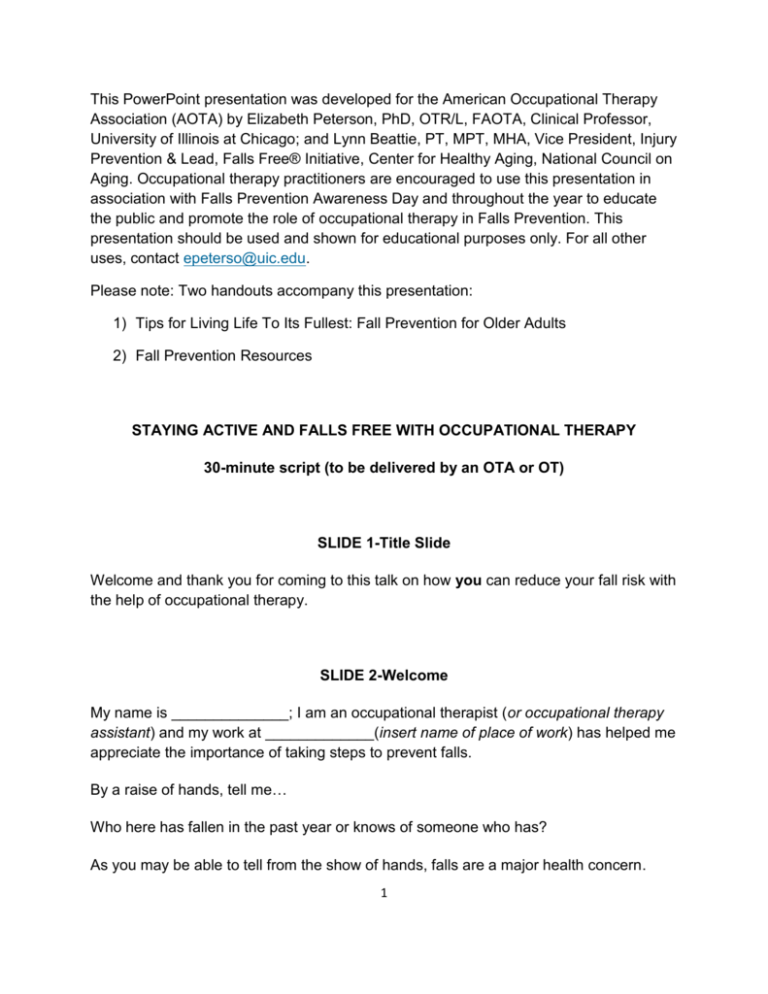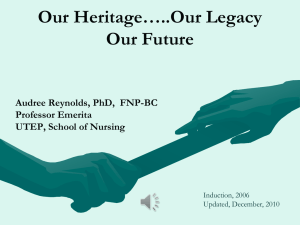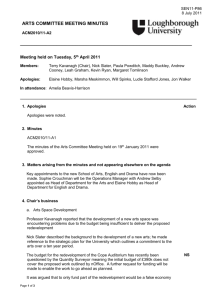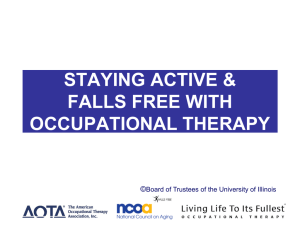30 minute Falls Prevention Script - American Occupational Therapy
advertisement

This PowerPoint presentation was developed for the American Occupational Therapy Association (AOTA) by Elizabeth Peterson, PhD, OTR/L, FAOTA, Clinical Professor, University of Illinois at Chicago; and Lynn Beattie, PT, MPT, MHA, Vice President, Injury Prevention & Lead, Falls Free® Initiative, Center for Healthy Aging, National Council on Aging. Occupational therapy practitioners are encouraged to use this presentation in association with Falls Prevention Awareness Day and throughout the year to educate the public and promote the role of occupational therapy in Falls Prevention. This presentation should be used and shown for educational purposes only. For all other uses, contact epeterso@uic.edu. Please note: Two handouts accompany this presentation: 1) Tips for Living Life To Its Fullest: Fall Prevention for Older Adults 2) Fall Prevention Resources STAYING ACTIVE AND FALLS FREE WITH OCCUPATIONAL THERAPY 30-minute script (to be delivered by an OTA or OT) SLIDE 1-Title Slide Welcome and thank you for coming to this talk on how you can reduce your fall risk with the help of occupational therapy. SLIDE 2-Welcome My name is ______________; I am an occupational therapist (or occupational therapy assistant) and my work at _____________(insert name of place of work) has helped me appreciate the importance of taking steps to prevent falls. By a raise of hands, tell me… Who here has fallen in the past year or knows of someone who has? As you may be able to tell from the show of hands, falls are a major health concern. 1 Falls can lead to injuries that can make everyday activities challenging. In some cases, concerns about falls can lead people to cut back on activities they are physically and mentally capable of performing. This is a problem because being inactive can raise your risk of falling. Staying active in a safe way keeps us physically fit, and engaged in life! <PAUSE> Although falls are the leading cause of injury and accidental death in adults over the age of 65, they can be prevented. By taking control of your health and utilizing the resources available to you, you can reduce your risk of falls and continue to do the things that you enjoy. You are not alone in your efforts to manage your fall risk. Occupational therapy practitioners, other health care providers, and many people in your community are dedicated to supporting your health and well-being. But you are the leader of your falls prevention team. SLIDE 3-Presentation Goals By the end of this presentation, which will take about 30 minutes, you will gain knowledge that will help you lead your health care team to reduce your risk of falls. Specifically, by the end of this presentation, you will be able to: • • • Recognize that most falls among older adults result from interacting risk factors. Describe how occupational therapy practitioners can help you reduce your risk of falls. Identify strategies and resources that you can use to reduce your risk for falls. I also have two (speaker, edit # as needed) handouts for you. One lists several helpful fall prevention resources. The other provides fall prevention tips. SLIDE 4- Why do Falls Happen? 2 A fall may be the first indicator of an acute problem, such as a cardiac arrhythmia. Or a fall may indicate a progression or onset of a chronic condition, such as Parkinson’s disease or multiple sclerosis. It may be related to changes in your medications or new medications. Or it may simply be a signal of the onset of age-related changes in our bodies, such as changes in vision. Of course sometimes falls just happen, due to accidents. But in most cases, falls experienced by older adults are caused by several risk factors coming together and interacting. SLIDE 5-Types of Fall Risk Factors Fall risk factors are commonly placed into three categories: Physical, behavioral, and environmental, but keep in mind that risk factors frequently interact to cause a fall. Physical risk factors relate to changes in your body that increase your risk for a fall. Impaired balance is an example of a physical risk factor. Behavioral risk factors are the things we do OR don’t do that increase our fall risk. For example, not asking for help when doing something that might cause a fall is a behavioral risk factor Environmental risk factors are typically hazards in our home or community such as loose throw rugs or unclear pathways, or even pets in our way! SLIDE 6 – Interacting Falls Risk Factors As an example of how these risk factors work in combination to increase fall risk, let’s consider this example. Let’s start by looking for some environmental risk factors. What environmental risk factors might put this woman at risk for a fall? (Refer to key that follows) ENVIRONMENTAL 3 Robe could get tangled up/belt is untied and could get caught. Shoes are slip on and could come off Kitchen is cluttered/walking areas are not clear—the vacuum is not put away. Stool is not stable. Instead she could use a step stool with a support bar. What behavioral risk factors are at work here? (Refer to key that follows) BEHAVIORAL She is reaching overhead while standing on a stool. Poor choice for a step stool. She should have organized her kitchen so the items she needs are within easy reach. She could have planned ahead and asked someone to help. We do not know if this person has any physical or medical problems that may be risk factors but many people have developed some physical risk factors with age. Sometimes these develop so gradually that we aren’t even aware of them. SLIDE 7- Minimizing Risk Factors It is important to remember that the risk of falling increases with the number of risk factors present. It might be difficult to get rid of all of our risk factors, but a little bit can go a long way because even small changes can make big difference! Consider this “tower analogy.” <PAUSE> Imagine you are building a tower of bricks, with one brick stacked up on the next. Each brick represents one risk factor. As the tower gets taller it becomes more unstable. Likewise, when your risk factors stack up, your risk of falling increases. The goal is to shrink the tower. We might always have some bricks or risk factors, especially since some risk factors, like having already fallen or getting older, cannot be changed, but we can shrink the tower and thereby reduce our risk for falls. 4 SLIDE 8 (Transition slide)-What is Occupational Therapy? Now that you have a better understanding of why most falls happen, let’s talk about the role of occupational therapy to help with fall prevention efforts. But before we do, let’s begin with the question, “What is occupational therapy?” By a raise of hands, who here has worked with an occupational therapy practitioner before, or know someone who has? SLIDE 9-About Occupational Therapy Occupational therapy helps people of every age do the things they want and need to do through the therapeutic use of everyday activities—or, as we refer to them— occupations. In other words, we use your everyday activities as part of the therapy process to help you remain as independent as possible and function as well as you can, despite injury, illness, or disability. SLIDE 10-About Occupations The term “occupation” refers to a person’s involvement in meaningful activities. Your life is made up of many occupations. My occupations include XXXXX. (Here offer approximately 3 examples of occupations that are important to you (e.g., activities related to taking care of your family, house, or pets; contributing to your community, and fulfilling your job responsibilities.) Your occupations, the day-to-day things you love to do, are linked to important roles in your life, such as being a grandparent, friend, volunteer, employee, spouse, or caregiver. Most of us are happiest when we engage in activities that reflect our values and identities. 5 However, very often, the fear of falling, or an injury caused from a fall, can keep us from doing the things we like to do. That is where occupational therapy comes in to help us safely do what is meaningful to us. SLIDE 11-Occupational Therapy Settings Occupational therapy practitioners work in many settings with people of all ages. These settings include, but are not limited to, schools, hospitals, medical centers, and workplaces. For our presentation today, let me offer a few examples of occupational therapy practice relevant to fall prevention. SLIDE 12- Rehabilitation Hospital–Based Occupational Therapy Occupational therapy practitioners working in rehabilitation hospitals help people who have sustained fall-related injuries by incorporating their everyday activities into therapy, which helps them to regain the skills and confidence they need to return home. SLIDE 13-Home and Community Based Occupational Therapy After a fall-related injury or to prevent a fall, occupational therapy practitioners also help older adults safely stay active in their own homes and communities. An occupational therapy practitioner teaches people safe ways to do valued activities and works with them to build strength, endurance, balance, and problem-solving skills. Evaluating the home for fall hazards, such as loose handrails, clutter on floors or stairs, or a slippery bathtub floor and addressing those types of problems are important steps in reducing fall risk in the home. SLIDE 14-Teamwork in Occupational Therapy 6 Occupational therapy practitioners work with colleagues inside and outside medical fields to help people to live life to its fullest. This team approach is particularly important when it comes to preventing falls. As we already discussed, falls typically occur due to a number of interacting risk factors. Health care providers must work together to address these diverse risk factors in a coordinated way. By learning about your own risk factors, you will be able to ensure that your health care providers are helping you to avoid a fall. SLIDE 15-The Role of Occupational Therapy in Falls Prevention Occupational therapy practitioners work with people at risk for falls to help them better understand and manage their risk factors—whether these are physical, behavioral, or environmental. For those with physical and mental changes that make it harder to do things, occupational therapy can be directed at improving skills and capabilities, like strength or balance or how we plan tasks; teaching people how to modify activities so they can do them safely; or changing the area or environment around them to reduce the risk of falls. Your home can be made safer by doing things like improving lighting, and removing tripping hazards like clutter and electrical cords. SLIDE 16-The Role of Occupational Therapy in Falls Prevention Occupational therapy practitioners also work with people after they have had a fall when their injury disrupts their ability to be involved in what they really want to do. They work with people who have sustained injuries such as hip fractures, wrist fractures, or head injuries after a fall to answer the question: “How can I do the things I need to do on a daily basis to care for myself and my home, and to fulfill my responsibilities? An occupational therapy practitioner can work with clients to help them problem solve the best way to dress themselves, tend their garden, shop for food and cook, safely stay involved in the community, or continue to do their favorite hobby. Occupational therapy starts with what people want to do, looks at what physical and other changes are interfering with this, and then determines strategies to help them do it safely. 7 For instance, a person coming home after being hospitalized for a hip fracture after a fall can be much more independent after learning how to bathe, dress, and move about using adaptive equipment. That equipment might include a reacher, a long-handled sponge, or a raised toilet seat. As I mentioned, occupational therapy practitioners can also help you build new skills and abilities to increase your capabilities. The types of capacities that can be developed with the help of occupational therapy range from thinking skills, such as planning and problem solving, to physical skills, such as getting into and out of a bathtub safely. Do you remember that at the beginning of this presentation I said that you are the leader of your fall prevention health care team? This is an important point. You are where any fall prevention effort begins and you must always be the focus. Your occupational therapy practitioner can help you manage your fall risk over the long term by teaching you fall risk management skills. These management skills include action planning, accessing resources, and creating strong partnerships with your health care providers while keeping you at the head of your team. <PAUSE> To learn more about fall prevention, let’s consider the story of Terry. Keep in mind, each occupational therapy program is unique and addresses the individual needs of a given client. However, Terry’s story will provide insights into how occupational therapy practitioners work with clients to reduce their fall risk. Terry’s story will also help you consider and act on fall risks in your own life. SLIDE 17- Case Example: Terry Terry is a 71-year-old man who works part time at a local home improvement store. He is overall in good health, and he has always considered himself to be athletic, since he was a star baseball player in high school. About 5 years ago, he developed diabetes and, because of his diabetes, he has some tingling and numbness in his feet. Recently, Terry was at home after a Sunday afternoon get-together with neighbors in his back yard. He fell when he was cleaning up after the party—he was carrying a lawn chair down the steps to his basement. He lost his footing on the last step and fell. 8 Terry fractured his right wrist, and he was referred to occupational therapy by his doctor right after his cast came off, because his wrist and fingers were stiff and swollen. This doctor also knew that an occupational therapist could help prevent a future fall. SLIDE 18-Terry’s Occupational Therapy Evaluation and Plan Terry saw his occupational therapist, Kate, in an outpatient clinic. After completing a thorough evaluation, Kate and Terry worked together to form a plan to help him continue doing his daily activities and reduce his risk of future falls. SLIDE 19-Terry’s Physical Risk Factors: Medications After asking Terry some pointed questions about how he was managing his diabetes. Kate learned that Terry was taking insulin and several over-the-counter medications, but he was not taking the medications consistently as directed. Kate explained that it is not unusual for a person to use many different types of over-the-counter and prescription medications. However, these medications can interact and create health problems that increase fall risk, especially if not taken as directed. Therefore, Kate told Terry that speaking with his doctor or pharmacist about his medications was an essential step to reduce his fall risk. Kate also explained the importance of staying hydrated since medications can reduce your hydration level, and that can lead to dizziness, confusion, or falls. Kate suspected that Terry’s peripheral neuropathy; that is, the nerve condition that caused tingling and numbness in his feet, played a role in his fall. Kate immediately contacted Terry’s doctor to suggest that Terry attend a diabetes management program in her hospital. SLIDE 20-Terry’s Physical Risk Factors: Vision Terry acknowledged that he had not had his eyes checked by an ophthalmologist, a medical and surgical eye specialist—or anyone—in three years. Kate explained that diabetes can affect vision and told Terry that by having regular eye exams and working with his eye doctor he could take steps to preserve his vision. She went on to say that exercise and sleep are also important to eye health, and emphasized that the key is to see the eye doctor on a regular basis. Terry agreed he needed to see his eye doctor and wrote it down in his calendar to make an appointment when he got home. 9 Because of Terry’s potential vision issues, Kate stressed to Terry the importance of having adequate lighting within reach throughout Terry’s house. Terry mentioned that he sometimes struggles to reach overhead lights in his living room. Kate recommended nightlights and sensor lights and reviewed with Terry where he might purchase these items. SLIDE 21–Terry’s Physical Risk Factors: Balance After observing Terry perform several tasks while he was in the clinic and through administering the Timed Up and Go Test, an easy way to see if someone has good balance, Kate shared her findings with Terry. Terry confirmed what Kate witnessed: he was not as steady on his feet as he used to be. This led to a discussion about balance. Kate told Terry that a person can improve balance at any age! She provided him with balance exercises that he could do at home, and ideas on how he could safely build balance skills. Kate also told Terry about community-based exercise programs, such as Tai Chi: Moving for Better Balance. Kate gave Terry the address of the local YMCA of the USA, which offered that Tai Chi program, and she encouraged Terry to talk with his doctor about it before signing up. Terry made a promise to Kate that he would check out the schedule at the Y and contact his doctor to be sure it was safe for him to attend. Kate and Terry planned to follow up on the progress of his new exercise routine at his next occupational therapy appointment. SLIDE 22–Terry’s Environmental Risk Factors: Fall Hazards Kate also provided Terry with a home safety brochure developed by the Centers for Disease Control and Prevention (CDC) that can be found on their Web site and talked with him to make sure he understood the information. Kate also talked about basic strategies to improve home safety, such clearing clutter from stairs and walkways, removing throw rugs, and using nonslip mats in the kitchen and bathroom. Terry felt the CDC materials and Kate’s suggestions were very helpful, and he was very interested in the checklist of common hazards in the home. Terry commented on how the home improvement store where he worked had a section devoted to safety in the home, and he thought it would be a good idea to install a grab 10 bar in his shower. Kate helped Terry complete a realistic, step-by-step plan to make sure he had the help he needed to get the grab bar and install it correctly. She also discussed the best location of the grab bar for Terry’s needs and talked to him about how to use it. Finally, given Terry’s balance concerns and wrist injury, Kate suggested a hand-held shower and shower chair for Terry. <PAUSE> In the course of their conversation, Terry mentioned his frail aunt who was living alone and asked about in-home safety evaluations. SLIDE 23-Terry’s Environmental Risk Factors: Fall Hazards Kate explained that occupational therapists do provide in-home safety assessments. She went on to say that research shows that home safety assessments and changes help reduce the risk of falling, especially when done by an occupational therapist. An occupational therapy home safety assessment involves carefully reviewing a person’s ability and determining whether the home environment fits the person and helps him or her stay independent. Room-by-room checks for safety hazards, combined with a thorough assessment of how the person moves around the home and the habits that increase or reduce the risk of falling, provide a complete picture of home safety. In short, Kate explained that evidence suggests that a one-size-fits-all approach to home safety will not reduce fall risks, and that each person must be looked at individually. <PAUSE> At this point, we have heard a lot about Terry’s physical and environmental risk factors. Now let’s consider how Terry’s behaviors can increase—or decrease—his fall risk. SLIDE 24-Terry’s Behavioral Risk Factors In order to look more closely at specific behaviors and determine Terry’s interests, Kate administered a questionnaire that let her know all of the occupations, or activities, that were important to Terry’s life, as well as those of interest to him and related to his longterm goals. Kate learned, for example, that Terry had not yet returned to his job at the home improvement store, but that job was very important to him. Kate found out that Terry had a supportive boss who planned to put him on light duty when he came back to work. 11 To help him best pursue this area of his life, Kate helped Terry gain a better understanding of what he could and could not do at work, building on the restrictions given to him by his physician. For instance, he was not allowed to do any activities that used a lot of pressure or force on his hand and wrist. Kate asked Terry specific questions about his job demands. Kate taught Terry how to problem solve and determine whether an activity was safe for him or not. With Kate’s help, Terry recognized that carrying or even bagging heavy items were against doctor’s orders, while activities such as writing or using a computer keyboard were important to his recovery. SLIDE 25-Terry’s Behavioral Risk Factors Kate and Terry then discussed the behaviors that may have led to Terry’s fall and injury. Before I reveal her recommendations, what are alternative ways that you think Terry could have used to get the patio furniture inside without putting him at risk for a fall? (Refer to key that follows) Delegate the task to someone else. Get help, so that Terry is not the only person carrying a chair. Use the rail on the stairs. Improve lighting on the stairs. Store the chairs in another location that is easier to access. SLIDE 26-Terry’s Behavioral Risk Factors Terry learned that carrying large objects while walking down stairs is something he should not attempt to do, especially since the sensation in his feet has been affected by his diabetes. But with Kate’s help, he determined that he could still do other things. Terry would have had no trouble carrying light folding chairs down his basement stairs, because he would still have one arm free to hold onto the hand rail. <PAUSE> Kate and Terry also talked about how Terry could get into the habit of planning ahead to make activities easier. She explained that the key is to stop, evaluate everything involved with the activity including safety risks, and make a plan. SLIDE 27-Summary of Terry’s Occupational Therapy Program 12 Kate focused on balance, vision, and medication use when working with Terry because she knew these are common physical risk factors. Kate’s evaluation also focused on Terry’s roles and occupations, and fall hazards in his home that led to a plan to make his bathroom safer. Terry’s fall prevention behaviors were an important focus of his occupational therapy. Overall, Kate and Terry worked together to make a comprehensive plan to manage Terry’s fall risk. <PAUSE> SLIDE 28-Fall Prevention Reflection Keeping in mind Terry’s story, what might you do or what have you done in the past to protect yourself from falls? Does anyone have tips to share that we haven’t covered? SLIDE 29-Summary of Strategies to Reduce Falls Risk To summarize all that we learned today, here is a review of things you can do to protect yourself from the possibility of a fall: (Refer to key that follows) Manage chronic illnesses or conditions Get an eye exam regularly Stay hydrated Talk to physicians and pharmacists about medications Stay active and exercise regularly Finding alternatives for potentially risky behaviors Identify and eliminate fall hazards in the home SLIDE 30-Conclusion Falls can be prevented! By taking charge of your health and utilizing the resources that are available to you, you can lower your chance of falls. Talk to your physician about services to help you prevent falls, like occupational therapy. 13 Note to speaker: It would be helpful to tell the audience here or elsewhere in the presentation about falls prevention related programs or services that are available in the community or offered by the site such as Matter of Balance or Stepping On, programs that are offered nationwide. <PAUSE> Do you have any questions? I have two handouts here for you: 1) Tips for Living Life To Its Fullest: Fall Prevention for Older Adults 2) Fall prevention resources Please feel free to pick them up. Thank you being such a great audience! SLIDE 31–Acknowledgement of Authors 14






